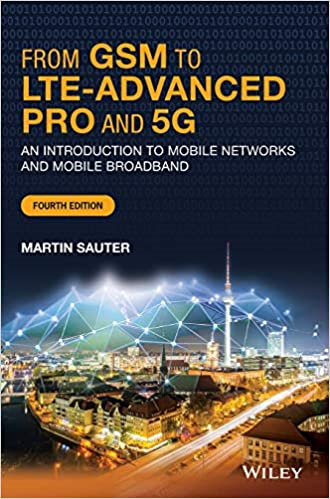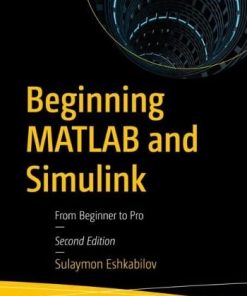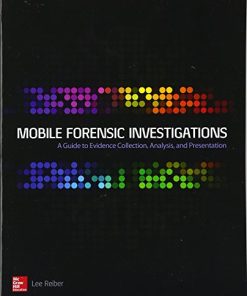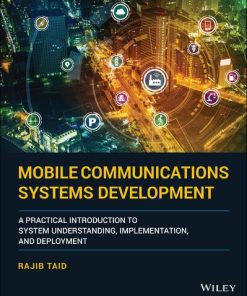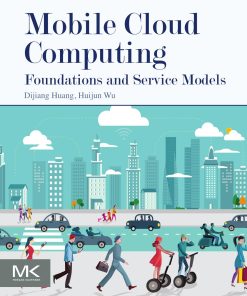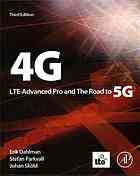From GSM to LTE-Advanced Pro and 5G: An Introduction to Mobile Networks and Mobile Broadband 4th Edition Martin Sauter
$50.00 Original price was: $50.00.$25.00Current price is: $25.00.
From GSM to LTE-Advanced Pro and 5G: An Introduction to Mobile Networks and Mobile Broadband 4th Edition – Ebook Instant Download/Delivery ISBN(s): 9781119714675,1119714672
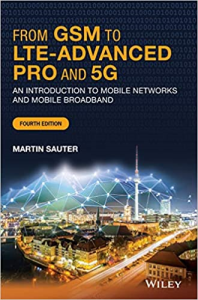
Product details:
- ISBN-10 : 1119714672
- ISBN-13 : 978-1119714675
- Author(s): Martin Sauter
A revised edition of the text that offers a comparative introduction to global wireless standards, technologies and their applications
The revised and updated fourth edition of From GSM to LTE-Advanced Pro and 5G: An Introduction to Mobile Networks and Mobile Broadband offers an authoritative guide to the technical descriptions of the various wireless technologies currently in use. The author―a noted expert on the topic―explains the rationale behind their differing mechanisms and implementations while exploring the advantages and limitations of each technology.
The fourth edition reflects the significant changes in mobile network technology that have taken place since the third edition was published. The text offers a new chapter on 5G NR that explores its non-standalone and standalone architecture. In the Wi-Fi chapter, additional sections focus on the new WPA3 authentication protocol, the new 802.11ax air interface and protocol extensions like 802.11k and 11v for meshed networks.
Table contents:
1 Global System for Mobile Communications (GSM)
1.1 Circuit‐Switched Data Transmission
1.1.1 Classic Circuit Switching
1.1.2 Virtual Circuit Switching over IP
1.2 Standards
1.3 Transmission Speeds
1.4 The Signaling System Number 7
1.4.1 The Classic SS‐7 Protocol Stack 7
1.4.2 SS‐7 Protocols for GSM
1.4.3 IP‐Based SS‐7 Protocol Stack
1.5 The GSM Subsystems
1.6 The Network Subsystem
1.6.1 The Mobile Switching Center (MSC), Server and Gateway
1.6.2 The Visitor Location Register (VLR)
1.6.3 The Home Location Register (HLR)
1.6.4 The Authentication Center
1.6.5 The Short Messaging Service Center (SMSC)
1.7 The Base Station Subsystem (BSS) and Voice Processing
1.7.1 Frequency Bands
1.7.2 The Base Transceiver Station (BTS)
1.7.3 The GSM Air Interface
1.7.4 The Base Station Controller (BSC)
1.7.5 The TRAU for Voice Encoding
1.7.6 Channel Coder and Interleaver in the BTS
1.7.7 Ciphering in the BTS and Security Aspects
1.7.8 Modulation
1.7.9 Voice Activity Detection
1.8 Mobility Management and Call Control
1.8.1 Cell Reselection and Location Area Update
1.8.2 The Mobile‐Terminated Call
1.8.3 Handover Scenarios
1.9 The Mobile Device
1.10 The SIM Card
1.11 The Intelligent Network Subsystem and CAMEL
Questions
References
2 General Packet Radio Service (GPRS) and EDGE
2.1 Circuit‐Switched Data Transmission over GSM
2.2 Packet‐Switched Data Transmission over GPRS
2.3 The GPRS Air Interface
2.3.1 GPRS vs. GSM Timeslot Usage on the Air Interface
2.3.2 Mixed GSM/GPRS Timeslot Usage in a Base Station
2.3.3 Coding Schemes
2.3.4 Enhanced Datarates for GSM Evolution (EDGE)
2.3.5 Mobile Device Classes
2.3.6 Network Mode of Operation
2.3.7 GPRS Logical Channels on the Air Interface
2.4 The GPRS State Model
2.5 GPRS Network Elements
2.5.1 The Packet Control Unit (PCU)
2.5.2 The Serving GPRS Support Node (SGSN)
2.5.3 The Gateway GPRS Support Node (GGSN)
2.6 GPRS Radio Resource Management
2.7 GPRS Interfaces
2.8 GPRS Mobility Management and Session Management (GMM/SM)
2.8.1 Mobility Management Tasks
2.8.2 GPRS Session Management
Questions
References
3 Universal Mobile Telecommunications System (UMTS) and High-Speed Packet Access (HSPA)
3.1 Overview
3.1.1 3GPP Release 99: The First UMTS Access Network Implementation
3.1.2 3GPP Release 4: Enhancements for the Circuit‐Switched Core Network
3.1.3 3GPP Release 5: High‐Speed Downlink Packet Access
3.1.4 3GPP Release 6: High‐Speed Uplink Packet Access (HSUPA)
3.1.5 3GPP Release 7: Even Faster HSPA and Continued Packet Connectivity
3.1.6 3GPP Release 8: LTE, Further HSPA Enhancements and Femtocells
3.2 Important New Concepts of UMTS
3.2.1 The Radio Access Bearer (RAB)
3.2.2 The Access Stratum and Non‐Access Stratum
3.2.3 Common Transport Protocols for CS and PS
3.3 Code Division Multiple Access (CDMA)
3.3.1 Spreading Factor, Chip Rate and Process Gain
3.3.2 The OVSF Code Tree
3.3.3 Scrambling in Uplink and Downlink Direction
3.3.4 UMTS Frequency and Cell Planning
3.3.5 The Near–Far Effect and Cell Breathing
3.3.6 Advantages of the UMTS Radio Network Compared to GSM
3.4 UMTS Channel Structure on the Air Interface
3.4.1 User Plane and Control Plane
3.4.2 Common and Dedicated Channels
3.4.3 Logical, Transport and Physical Channels
3.4.4 Example: Network Search
3.4.5 Example: Initial Network Access Procedure
3.4.6 The Uu Protocol Stack
3.5 The UMTS Terrestrial Radio Access Network (UTRAN)
3.5.1 Node‐B, Iub Interface, NBAP and FP
3.5.2 The RNC, Iu, Iub and Iur Interfaces, RANAP and RNSAP
3.5.3 Adaptive Multirate (AMR) NB and WB Codecs for Voice Calls
3.5.4 Radio Resource Control (RRC) States
3.6 Core Network Mobility Management
3.7 Radio Network Mobility Management
3.7.1 Mobility Management in the Cell‐DCH State
3.7.2 Mobility Management in Idle State
3.7.3 Mobility Management in Other States
3.8 UMTS CS and PS Call Establishment
3.9 UMTS Security
3.10 High‐Speed Downlink Packet Access (HSDPA) and HSPA+
3.10.1 HSDPA Channels
3.10.2 Shorter Delay Times and Hybrid ARQ (HARQ)
3.10.3 Node‐B Scheduling
3.10.4 Adaptive Modulation and Coding, Transmission Rates and Multicarrier Operation
3.10.5 Establishment and Release of an HSDPA Connection
3.10.6 HSDPA Mobility Management
3.11 High‐Speed Uplink Packet Access (HSUPA)
3.11.1 E‐DCH Channel Structure
3.11.2 The E‐DCH Protocol Stack and Functionality
3.11.3 E‐DCH Scheduling
3.11.4 E‐DCH Mobility
3.11.5 E‐DCH‐Capable Devices
3.12 Radio and Core Network Enhancements: CPC and One Tunnel
3.12.1 A New Uplink Control Channel Slot Format
3.12.2 CQI Reporting Reduction and DTX and DRX
3.12.3 HS‐SCCH Discontinuous Reception
3.12.4 HS‐SCCH‐less Operation
3.12.5 Enhanced Cell‐FACH and Cell/URA‐PCH States
3.13 Radio Resource State Management
3.14 Automated Emergency Calls (eCall) from Vehicles
Questions
References
4 Long Term Evolution (LTE) and LTE-Advanced Pro
4.1 Introduction and Overview
4.2 Network Architecture and Interfaces
4.2.1 LTE Mobile Devices and the LTE Uu Interface
4.2.2 The eNode‐B and the S1 and X2 Interfaces
4.2.3 The Mobility Management Entity (MME)
4.2.4 The Serving Gateway (S‐GW)
4.2.5 The PDN‐Gateway
4.2.6 The Home Subscriber Server (HSS)
4.2.7 Billing, Prepaid and Quality of Service
4.3 FDD Air Interface and Radio Network
4.3.1 OFDMA for Downlink Transmission
4.3.2 SC‐FDMA for Uplink Transmission
4.3.3 Quadrature Amplitude Modulation for Subchannels
4.3.4 Symbols, Slots, Radio Blocks and Frames
4.3.5 Reference and Synchronization Signals
4.3.6 The LTE Channel Model in the Downlink Direction
4.3.7 Downlink Management Channels
4.3.8 System Information Messages
4.3.9 The LTE Channel Model in the Uplink Direction
4.3.10 MIMO Transmission
4.3.11 HARQ and Other Retransmission Mechanisms
4.3.12 PDCP Compression and Ciphering
4.3.13 Protocol Layer Overview
4.4 TD‐LTE Air Interface
4.5 Scheduling
4.5.1 Downlink Scheduling
4.5.2 Uplink Scheduling
4.6 Basic Procedures
4.6.1 Cell Search
4.6.2 Attach and Default Bearer Activation
4.6.3 Handover Scenarios
4.6.4 Default and Dedicated Bearers
4.7 Mobility Management and Power Optimization
4.7.1 Mobility Management in RRC Connected State
4.7.2 Mobility Management in RRC Idle State
4.7.3 Mobility Management and State Changes in Practice
4.8 LTE Security Architecture
4.9 Interconnection with UMTS and GSM
4.9.1 Cell Reselection between LTE and GSM/UMTS
4.9.2 RRC Connection Release with Redirect between LTE and GSM/UMTS
4.9.3 Handover from LTE to UMTS
4.9.4 Returning from UMTS and GPRS to LTE
4.11 Carrier Aggregation
4.11.1 CA Types, Bandwidth Classes and Band Combinations
4.11.2 CA Configuration, Activation and Deactivation
4.11.3 Uplink Carrier Aggregation
4.12 Network Planning Aspects
4.12.1 Single Frequency Network
4.12.2 Cell‐Edge Performance
4.12.3 Self‐Organizing Network Functionality
4.12.4 Cell Site Throughput And Number of Simultaneous Users
4.13 CS‐Fallback for Voice and SMS Services with LTE
4.13.1 SMS over SGs
4.13.2 CS‐Fallback for Voice Calls
4.15 Network Sharing – MOCN and MORAN
4.15.1 National Roaming
4.15.2 MOCN (Multi‐Operator Core Network)
4.15.3 MORAN (Mobile Operator Radio Access Network)
4.16 From Dipoles to Active Antennas and Gigabit Backhaul
4.17 IPv6 in Mobile Networks
4.17.1 IPv6 Prefix and Interface Identifiers
4.17.2 IPv6 and International Roaming
4.17.3 IPv6 and Tethering
4.17.4 IPv6‐Only Connectivity
4.18 Network Function Virtualization
4.18.1 Virtualization on the Desktop
4.18.2 Running an Operating System in a Virtual Machine
4.18.3 Running Several Virtual Machines Simultaneously
4.18.4 Virtual Machine Snapshots
4.18.5 Cloning a Virtual Machine
4.18.6 Virtualization in Data Centers in the Cloud
4.18.7 Managing Virtual Machines in the Cloud
4.18.8 Network Function Virtualization
4.18.9 Virtualizing Routers
4.18.10 Software‐Defined Networking
4.19 Machine Type Communication and the Internet of Things
4.19.1 LTE Cat‐1 Devices
4.19.2 LTE Cat‐0 Devices and PSM
4.19.3 LTE Cat‐M1 Devices
4.19.4 LTE NB1 (NB‐IoT) Devices
4.19.5 NB‐IoT – Deployment Options
4.19.6 NB‐IoT – Air Interface
4.19.7 NB‐IoT – Control Channels and Scheduling
4.19.8 NB‐IoT Multicarrier Operation
4.19.9 NB‐IoT Throughput and Number of Devices per Cell
4.19.10 NB‐IoT Power Consumption Considerations
4.19.11 NB‐IoT – High Latency Communication
4.19.12 NB‐IoT – Optimizing IP‐Based and Non‐IP‐Based Data Transmission
4.19.13 NB‐IoT Summary
Questions
References
5 VoLTE, VoWifi and Mission Critical Communication
5.1 Overview
5.2 The Session Initiation Protocol (SIP)
5.3 The IP Multimedia Subsystem (IMS) and VoLTE
5.3.1 Architecture Overview
5.3.2 Registration
5.3.3 VoLTE Call Establishment
5.3.4 LTE Bearer Configurations for VoLTE
5.3.5 Dedicated Bearer Setup with Preconditions
5.3.6 Header Compression and DRX
5.3.7 Speech Codec and Bandwidth Negotiation
5.3.8 Alerting Tone, Ringback Tone and Early Media
5.3.9 Port Usage
5.3.10 Message Filtering and Asserted Identities
5.3.11 DTMF Tones
5.3.12 SMS over IMS
5.3.13 Call Forwarding Settings and XCAP
5.3.14 Single Radio Voice Call Continuity
5.3.15 Radio Domain Selection, T‐ADS and VoLTE Interworking with GSM and UMTS
5.3.16 VoLTE Emergency Calls
5.4 VoLTE Roaming
5.4.1 Option 1: VoLTE Local Breakout
5.4.2 Option 2: VoLTE S8‐Home Routing
5.5 Voice over WiFi (VoWifi)
5.5.1 VoWifi Network Architecture
5.5.2 VoWifi Handover
5.5.3 Wi‐Fi‐Preferred vs. Cellular‐Preferred
5.5.4 SMS, MMS and Supplementary Services over Wi‐Fi
5.5.5 VoWifi Roaming
5.6 VoLTE Compared to Fixed‐Line IMS in Practice
5.7 Mission Critical Communication (MCC)
5.7.1 Overview
5.7.2 Advantages of LTE for Mission Critical Communication
5.7.3 Challenges of Mission Critical Communication for LTE
5.7.4 Network Operation Models
5.7.5 Mission Critical Push To Talk (MCPTT) – Overview
5.7.6 MCPTT Group Call Establishment
5.7.7 MCPTT Floor Control
5.7.8 MCPTT Group Call Types
5.7.9 MCPTT Configuration and Provisioning
5.7.10 eMBMS for MCPTT
5.7.11 Priority and Quality of Service
Questions
References
6 – 5G New Radio (NR) and the 5G Core
6.1 Introduction and Overview 3
6.1.1 Reasons For Initially Launching 5G as a Hybrid Solution 4
6.1.2 Frequency Range 1 and 2 4
6.1.3 Dynamic Spectrum Sharing in Low- And Mid-Bands 5
6.1.4 Network Deployments and Organization of this Chapter 5
6.2 5G NR Non-Standalone (NSA) Architecture 6
6.2.1 Network Architecture and Interfaces 6
6.2.2 3GPP 5G Deployment Options 1-7 and Dynamic Spectrum Sharing 8
6.2.2 Option 3, 3A and Option 3X 10
6.2.3 Fronthaul Interface 11
6.3 5G TDD Air Interface 12
6.3.1 Flexible OFDMA for Downlink Transmission 13
6.3.3 The 5G Resource Grid – Symbols, Slots, Resource Blocks and Frames 16
6.3.4 Synchronization and Reference Signals 18
6.3.5 Massive-MIMO for Beamforming and Multi-User Data Transfer 19
6.3.6 TDD Slot Formats 22
6.3.7 Downlink Control Channels 24
6.3.8 Uplink Channels 25
6.3.9 Bandwidth Parts 26
6.3.10 The Downlink Control Channel and Scheduling 28
6.3.11 Downlink Data Throughput in Theory and Practice 30
6.3.12 Uplink Data Throughput 32
6.3.13 TDD Air Interface for mmWave Bands (FR2) 33
6.4 5G FDD Air Interface 34
6.4.1 Refarming and Dynamic Spectrum Sharing 36
6.5 EN-DC Bearers and Scheduling 41
6.5.1 Split Bearers, Flow Control 42
6.5.3 Two UE Transmitter Requirement for EN-DC 43
6.6 Basic Procedures and Mobility Management in Non-Standalone Mode 45
6.6.1 Establishment of an LTE-Only Bearer as 5G Anchor 45
6.6.2 5G NR Cell Addition in Non-Standalone Mode 48
6.6.3 When to Show a 5G Indicator 53
6.6.4 Handover Scenarios 54
6.6.5 EN-DC Signaling Radio Bearers 56
6.6.6 5G Non-Standalone and VoLTE 57
6.7 Network Planning and Deployment Aspects 57
6.7.1 The Range of Band n78 58
6.7.2 Backhaul Considerations 58
6.8 5G NR Standalone (SA) Architecture and Basic Procedures 58
6.8.1 5G Core Network Functions 59
6.8.2 Network Interfaces 61
6.8.3 Subscriber and Device Identifiers 62
6.8.4 5G Core Network Procedures Overview 62
6.8.5 Connection Management 63
6.8.6 Registration Management Procedure 63
6.8.7 Session Management 65
6.8.8 Special Session Management Features 68
6.8.9 Mobility Management 69
6.8.10 New Security Features 70
6.8.11 The 5G Core and different RAN Deployments 72
6.8.12 5G and 4G Core Network Interworking 73
6.8.13 The 5G Core Network and SMS 77
6.8.14 Cloud Native 5G Core 77
6.9 The 5G Air Interface in Standalone Operation 80
6.9.1 RRC Inactive State 80
6.9.2 System Information Messages 81
6.9.3 Measurement Configuration, Events and Handovers 82
6.10 Future 5G Functionalities 83
6.10.1 Voice Service in 5G 83
6.10.2 Ethernet and Unstructured PDU Session Types 85
6.10.3 Network Slicing 85
Questions 86
References 87
7 Wireless Local Area Network (WLAN)
7.1 Wireless LAN Overview
7.2 Transmission Speeds and Standards
7.3 WLAN Configurations: From Ad Hoc to Wireless Bridging
7.3.1 Ad Hoc, BSS, ESS and Wireless Bridging
7.3.2 SSID and Frequency Selection
7.4 Management Operations
7.5 The MAC Layer
7.5.1 Air Interface Access Control
7.5.2 The MAC Header
7.6 The Physical Layer and MAC Extensions
7.6.1 IEEE 802.11b – 11 Mbit/s
7.6.2 IEEE 802.11 g with up to 54 Mbit/s
7.6.3 IEEE 802.11a with up to 54 Mbit/s
7.6.4 IEEE 802.11n with up to 600 Mbits/s
7.6.5 IEEE 802.11 ac – WiFi5 – Gigabit Wireless
7.6.6 IEEE 802.11ax – Wi-Fi 6 – High Efficiency Extensions
7.6.7 IEEE 802.11ad – Gigabit Wireless at 60 GHz
7.7 Wireless LAN Security
7.7.1 Wired Equivalent Privacy (WEP) and Early Security Measures
7.7.2 WPA and WPA2 Personal Mode Authentication
7.7.3 WPA and WPA2 Enterprise Mode Authentication – EAP‐TLS
7.7.4 WPA and WPA2 Enterprise Mode Authentication – EAP‐TTLS
7.7.5 WPA and WPA2 Enterprise Mode Authentication – EAP‐PEAP
7.7.6 WPA and WPA2 Enterprise Mode Authentication – EAP‐SIM
7.7.7 WPA and WPA2 Encryption
7.7.8 Wi‐Fi‐Protected Setup (WPS)
7.7.9 WPA3 Personal Mode Authentication
7.7.10 Protected Management Frames
7.8 IEEE 802.11e and WMM – Quality of Service
Questions
References
8 Bluetooth and Bluetooth Low Energy
8.1 Overview and Applications
8.2 Physical Properties
8.3 Piconets and the Master/Slave Concept
8.4 The Bluetooth Protocol Stack
8.4.1 The Baseband Layer
8.4.2 The Link Controller
8.4.3 The Link Manager
8.4.4 The HCI Interface
8.4.5 The L2CAP Layer
8.4.6 The Service Discovery Protocol
8.4.7 The RFCOMM Layer
8.4.8 Overview of Bluetooth Connection Establishment
8.5 Bluetooth Security
8.5.1 Pairing up to Bluetooth 2.0
8.5.2 Pairing with Bluetooth 2.1 and Above (Secure Simple Pairing)
8.5.3 Authentication
8.5.4 Encryption
8.5.5 Authorization
8.5.6 Security Modes
8.6 Bluetooth Profiles
8.6.1 Basic Profiles: GAP, SDP and the Serial Profile
8.6.2 Object Exchange Profiles: FTP, Object Push and Synchronize
8.6.3 Headset, Hands‐Free and SIM Access Profile
8.6.4 High‐Quality Audio Streaming
8.6.5 The Human Interface Device (HID) Profile
8.7 Bluetooth Low Energy
8.7.1 Introduction
8.7.2 The Lower BLE Layers
8.7.3 BLE SMP, GAP and Connection Establishment
8.7.4 BLE Authentication, Security and Privacy
8.7.5 BLE ATT and GATT
8.7.6 Practical Example
8.7.7 BLE Beacons
8.7.8 BLE and IPv6 Internet Connectivity
Questions
References
Index
People also search:
lte advanced pro vs 5g
from gsm to lte-advanced pro and 5g 4th edition
4g lte-advanced pro and the road to 5g
from gsm to lte-advanced pro and 5g pdf
can lte phones use 5g
can 5g phone use 4g network
lte advanced pro
do gsm phones still work
You may also like…
Engineering - Telecommunications
Computers - Applications & Software
Beginning MATLAB and Simulink: From Beginner to Pro 2nd Edition
Engineering - Robotics & Artificial Intelligence
Build Autonomous Mobile Robot from Scratch using ROS: Simulation and Hardware
Engineering - Mechanical Engineering & Dynamics
Religion & Spirituality - Religious Studies
An Introduction to the Philosophy of Religion 4th Edition Brian Davies


